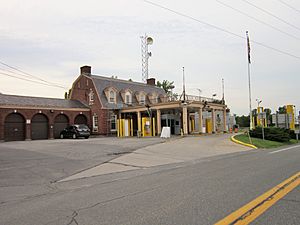Overton Corners–Lacolle 221 Border Crossing facts for kids
Quick facts for kids Overton Corners-Lacolle 221 Border Crossing |
|
|---|---|

US Border Station at Overton Corners, NY
|
|
| Location | |
| Country | United States; Canada |
| Location |
|
| Coordinates | 45°00′36″N 73°24′01″W / 45.009886°N 73.400195°W |
| Details | |
| Opened | 1913 |
| US Phone | (518) 298-3182 |
| Canadian Phone | (800) 461-9999 |
| Hours | Open 24 Hours |
|
U.S. Inspection Station—Rouses Point (Overton Corners), New York
|
|
| Lua error in Module:Location_map at line 420: attempt to index field 'wikibase' (a nil value). | |
| Location | NY 276, Rouses Point, New York |
| Built | 1931 |
| Architect | Louis A. Simon, James A. Wetmore |
| Architectural style | Georgian Revival |
| MPS | U.S. Border Inspection Stations MPS |
| NRHP reference No. | 14000573 |
| Added to NRHP | September 10, 2014 |
The Overton Corners–Lacolle 221 Border Crossing is a special place where Canada and the United States meet. It connects Lacolle, Quebec in Canada to Champlain, New York in the US. This border crossing is open all day, every day, all year long!
It's called "221" because it's on Quebec Route 221. The US side is sometimes called "276" for New York State Route 276. Another crossing, the Rouses Point–Lacolle 223 Border Crossing, is nearby to the east.
Long ago, during a time called the Prohibition Era (when alcohol was illegal in the US), this crossing was super busy. People tried to smuggle alcohol across the border. This often caused long lines of cars waiting to enter the US.
The main building on the US side is very old and special. It was built in a style called Georgian Revival. In 2014, it was added to the National Register of Historic Places. This means it's an important historic site.
Contents
The Overton Corners Border Station
What the Building Looks Like
The Overton Corners Border Inspection Station is a red brick building. It sits at a bend in New York State Route 276. The Canadian border station is right next door.
The main part of the building has 1 1/2 stories. It has two smaller, one-story wings on its sides. There's also a special area for checking trucks. A canopy extends from the front, covering three lanes for cars.
The roof is covered in slate. The building has brick corners and stone details around the windows. The windows on the first floor have 12 panes. The windows on the second floor are arched.
Inside the Station
When you go inside, the first floor is a big open space. There are counters that separate the public area from offices. The floors are made of red tile.
Upstairs, on the second floor, there are more rooms. These include detention rooms and offices. These spaces are not used much anymore.
Over the years, some changes have been made to the building. A truck dock was added in 1958. A backup power generator was put in in 1966. The main entrance was also updated in 1968.
Why This Border Station is Important
Built During a Special Time
The Overton Corners Border Station was built between 1931 and 1932. It was one of seven similar stations built along the New York-Canada border. These buildings were designed by architects working for the US government.
The station was built during three important times in US history. First, it was during the Prohibition Era, when alcohol was illegal. Second, it was after the Public Buildings Act of 1926. This law allowed the government to build many new public buildings. Third, it was when cars became very popular and affordable.
The government built these stations to help control smuggling. People often tried to bring illegal alcohol across the border in their cars. Building these stations also helped create jobs for many people during the Great Depression.
A Well-Preserved Historic Site
The Overton Corners station is one of the best-preserved border stations in New York. It still looks much like it did when it was first built. Even with a few changes, it keeps its original charm.
This station is a great example of the Georgian Revival style. This style was popular for government buildings at the time. It shows how the government wanted its buildings to look strong and classic.
History of the Border Crossing
The Prohibition Era and Smuggling
Prohibition started in 1920, making alcohol illegal across the US. This led to a lot of illegal alcohol being brought in from Canada. This was called "bootlegging."
At first, only a few officers tried to stop the smugglers. They often worked on foot or horseback. Travelers were supposed to report their purchases at customs houses, but these were often far from the border.
The Public Buildings Act of 1926 helped change this. It gave money to build new, proper border stations. This made it easier to stop bootlegging.
The "Rum Trail"
Rouses Point, near Overton Corners, was a main spot for bootleggers. They used a route called the "Rum Trail." This was Route 9 between St. Jean in Canada and Plattsburgh, New York in the US.
The Overton Corners station was very important. It was on the only paved road across the border at the time. This meant many people used it.
Even after Prohibition ended in 1933, smuggling didn't stop. People still wanted Canadian alcohol. Also, some people smuggled raw alcohol into Canada, where it was more expensive. The station continued to work hard to stop these activities.
The Overton Corners station was finished in 1932. It has been in active use for many decades, helping to keep the border safe.

